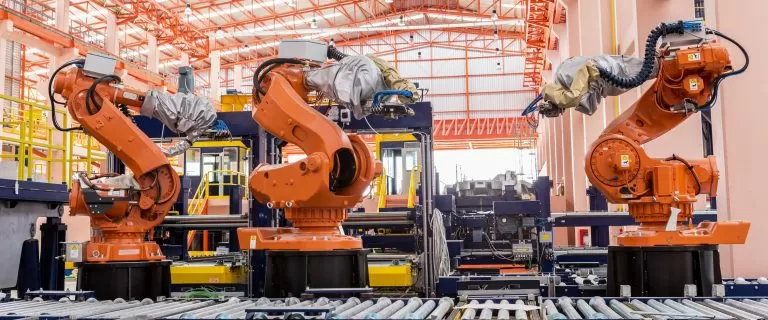Check out our White Paper Series!
A complete library of helpful advice and survival guides for every aspect of system monitoring and control.
1-800-693-0351
Have a specific question? Ask our team of expert engineers and get a specific answer!
Sign up for the next DPS Factory Training!

Whether you're new to our equipment or you've used it for years, DPS factory training is the best way to get more from your monitoring.
Reserve Your Seat Today
Machinery and equipment are the core of modern industrial operations - without them, there is no operation. When machinery works as designed, products are made; when it doesn't, they're not.
Operating budgets and company profitability are based on an anticipated amount of uptime per piece of machinery. So, improving maintenance reliability increases machine uptime percentages, while safeguarding revenue.
Conversely, the over-dedication of maintenance resources to industrial machinery can diminish profitability, as the cost of direct equipment monitoring increases. To optimize the cost of monitoring vs. the benefit of increased uptime, industrial operations must be monitored as efficiently as possible.
As the Internet of Things (IoT) arrives in full force, remote monitoring of industrial machinery is the most efficient means of improving equipment uptime.
Developing a remote monitoring system can be a complex and challenging endeavor, especially if it's outside of your previous training and expertise. To help you get started, we are sharing this guide for the remote monitoring of industrial equipment for 2020-2021.
The best time to fix industrial machinery is before it breaks. Take a simple example: is it better to change the oil in a car's engine before or after it becomes so viscous it seizes the motor on the highway?
Like oil changes, much of the preventative maintenance required by industrial machinery is based on preset standards, developed by engineers. By analyzing historical data, engineers set standards which should prevent equipment issues from arising.
To continue the example, oil changes are recommended every 3,000 miles because data has proven that doing so prevents damage to the motor from poor oil quality or quantity. After 3,000 miles, problems will arise with increasing frequency and severity.
This type of maintenance is called scheduled maintenance, which is a type of preventative maintenance. The thought is that by following the schedule, equipment issues will be prevented.
Schedules are based on historical observations and are accurate to the limits of researchers observational and deductive abilities.
Sadly, this isn't good enough. Even the best researchers are only human. Their powers of observation and analysis are limited. Not all variables have been accounted for, and not all principles are understood.
Even if you changed your oil 200 miles ago, your motor can still seize. The general schedule your maintenance is based on didn't account for the leak in your oil pan. The rules of mankind may describe parts of the world for a while, but they don't control them.
So, what can we do to handle real-world random events?
The second, more accurate type of preventative maintenance is responsive maintenance. This maintenance relies on direct observation of equipment conditions. When an issue is observed - the big puddle of oil in the driveway - corrective action is taken (replacing the oil pan).
This type of maintenance does not prevent problems entirely. Instead, it seeks to detect problems as early as possible, minimizing their severity by preventing them from worsening.
In order to catch problems early, equipment must be monitored frequently.
Hiring human technicians to constantly monitor each piece of industrial machinery for emerging maintenance conditions is cost-prohibitive to the point of absurdity. No business would ever do that.
It's also ineffective. People get bored. Staring at a gauge all day for even a week is a good way to stop seeing that gauge entirely.
Here's where the acronyms come in. Instead of relying on human observers, the industry now has advanced technologically to the point where the machines themselves can report on their condition in real-time. This is IoT (which more and more readers will recognize as "Internet of Things").
When the machines report their condition to a central server for human managers to review, you have a SCADA (Supervisory Control and Data Acquisition) system.
Industrial machines can report their condition themselves, using built-in sensor networks and transmitters. Or, separate devices known as remote terminal units (RTUs) can sense a wide variety of equipment and environmental conditions.
RTUs transmit this sensor data, commonly to a central device known as a master station. Master stations translate the languages of many different RTUs and self-monitoring devices, and then this information can be read from a central computer screen.
SCADA allows a handful of employees to monitor large industrial areas. If a certain machine is having airflow issues, monitors can inform maintenance teams, who will replace air filters.
If another is overheating, maintenance teams will know to check the coolant and fan belts. Using a SCADA system helps prevent equipment downtime by alerting personnel to issues before they become severe.
That does not mean, however, that a SCADA remote monitoring and control system should replace scheduled maintenance - to the contrary, it should inform it. The data a network of industrial machines creates is specific to those machines, each in their own unique place.
The trends observed are more likely to be predictive of future maintenance needs because they arise from the same real-world conditions future machinery will be subject to.
To summarize, a robust maintenance program for industrial machinery in 2020-2021 will:
Doing so will increase equipment uptime, reduce costly breakdowns, keep human resources needs sustainable, and prolong working equipment lifespans.
DPS Telecom has industry leading experience and expertise in SCADA and industrial remote monitoring. To learn more, reach out and get a quote today!
Image courtesy Shutterstock